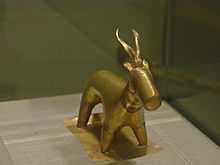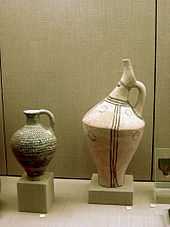Akrotiri (Santorini)

- See also Akrotiri (disambiguation).
Akrotiri is a Minoan Bronze Age settlement on the volcanic Greek island of Santorini (Thera). The settlement was destroyed in the Theran eruption about 1627 BCE and buried in volcanic ash, which preserved the remains of fine Frescoes and many objects and artworks. The settlement has been suggested as a possible inspiration for Plato's story of Atlantis. The site has been excavated since 1967.
Minoan settlement

The Akrotiri excavation site is of a Minoan Bronze Age settlement on the Greek island of Santorini, associated with the Minoan civilization due to inscriptions in Linear A, and close similarities in artifact and fresco styles.[1] The excavation is named for a modern Greek village situated on a hill nearby. The name of the site in antiquity is unknown.
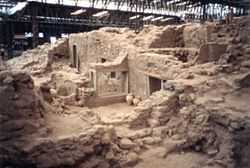
Akrotiri was buried by the widespread Theran eruption in the middle of the second millennium BC[2] (during the Late Minoan IA period); as a result, like the Roman ruins of Pompeii after it, it is remarkably well-preserved. Frescoes,[3] pottery, furniture, advanced drainage systems and three-story buildings have been discovered at the site,[4] whose excavation was started in 1967 by Spyridon Marinatos.
Some historians hold that this settlement, as well as the disaster that left it unknown to most of history, as the inspiration behind Plato's story of Atlantis, as mentioned in his dialogues Timaeus and Critias. Excavated artifacts have been installed in a museum distant from the site (Museum of Prehistoric Thera), with many objects and artworks presented. Only a single gold object has been found, hidden beneath flooring, and no uninterred human skeletal remains have been found. This indicates that an orderly evacuation was performed with little or no loss of life.
An ambitious modern roof structure, meant to protect the site, collapsed just prior to its completion in 2005, killing one visitor.[5] No damage was caused to the antiquities.[6] As a result, the site was closed to visitors until April 2012.[7]
Gallery of Akrotiri frescos from various museums

-

Image of a town
-
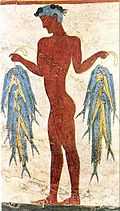
Fisherman
-

Decorative rosettes
-

Gathering saffron
-
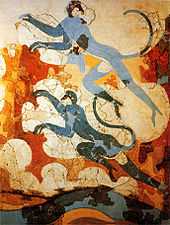
Blue monkeys
-

Woman with papyrus
-

Boxing youth
Gallery of museum objects on Santorini
Most of the images here have been color corrected by the Picture Workshop of the German Wikipedia de:Wikipedia:Bilderwerkstatt. The yellow light (without the energetic blue wavelengths) used in the museum greatly reduces the fading of colors. Differences in technical approach and guesses at appropriate coloration have led to variations in color rendering.
-
Marble schematic figurine -
-

-

-
-

-

-
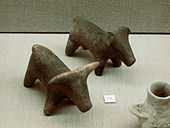
Animal figurines -
Gold ibex - the only gold object found as of 2007 (camera image) -
Ewers -

Volcanic ash cast of a wooden table -
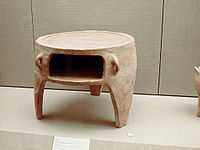
Oven -

Firedogs -

-
-
-

-

Akrotiri today: the connecting path
Connecting the old excavation site to the town of Akrotiri, there is a path descending from the first houses of the small city to the parking lot of the excavations of Akrotiri. The path has been both recently signaled and reopened (on September 2012) now regularly undergoing maintenance thanks to international volunteers responding to Citizens in Action call. The local population has been the first supporter of this initiative and in charge of the keeping of the path as been involved working along with the volunteers. The path is suitable for Mountain Bikes riding, walking and much more activities. If a right deviation is taken along the walking of the path you might reach the Red Beach area.
| Wikimedia Commons has media related to Akrotiri. |
References
- ↑ Christos G. Doumas, Thera - Pompeii of the Ancient Aegean, London 1983
- ↑ Floyd W. McCoy and Grant Heiken, Volcanic Hazards and Disasters in Human Antiquity, 2000
- ↑ Christos G. Doumas, The Wall Paintings of Thera, Athens 1991
- ↑ C. Michael Hogan, Akrotiri, The Modern Antiquarian
- ↑ "Canopy collapse kills visitor to Santorini", International Herald Tribune, Sept. 2005
- ↑ Although, those charged with criminal negligence were charged with "damaging a monument". Staff (3 March 2011) "Trial for fatal Santorini roof collapse to begin next week: Twelve people to appear in court in connection to death of one tourist and damage to ancient site" Ekathimerini.Com, archived here by WebCite
- ↑ "Άνοιξε ο αρχαιολογικός χώρος του Ακρωτηρίου Σαντορίνης," Ta Nea, April 10, 2012
External links
- Guided Tours
- Official website of the archaeological site
- A visitor's account
- Akrotiri - Santorini's Mystery
- The archaeological site of Akrotiri
- Greek news report on 2005 roof collapse
Coordinates: 36°21′05″N 25°24′13″E / 36.35139°N 25.40361°E
| ||||||||



